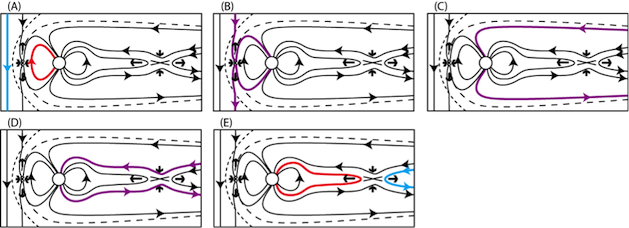SMILE
SMILE
Information


SCIENCE
The key science questions for SMILE are:
- What are the fundamental models of the dayside solar wind/magnetosphere interaction?
- What defines the substorm cycle?
- How do Coronal Mass Ejections (CME) driven storms arise and what is their relationship to substorms?
SMILE will determine when and where transient and steady magnetopause reconnection dominates.
Dayside reconnection causes plasma to flow antisunward through the mangetopause boundaries, the cusps, and over the polar caps. Reconnection can persist for long periods, or be bursty and patchy. It is unclear whether steady reconnection occurs when the plasma beta is low (when the incoming Interplanetary Magnetic Field (IMF) pressure dominates), and whether unsteady reconnection happens when the converse is true, during high plasma beta conditions. SMILE will test this hypothesis by determining the location and evolution over time of the magnetopause boundary. SMILE will also measure the proton cusp spot latitude, extent in longitude and the proton cusp spot intensity. Measurements of the proton cusp will be used to determine whether the magnetopause has experience compression, spatially constrain the X-line (the region over which magnetic reconnection occurs) and determine whether steady or bursty reconnection has happened.
The trigger that leads to substorm onset remains controversial. Southward turnings of the Interplanetary Magnetic Field (IMF) are required to add energy to the magnetotail lobes. However, the precise nature of how the energy is loaded into the tails and how this precedes a period of enhanced geomagnetic activity is an area of much controversy. A substorm may start after the magnetotail is squeezed by an increase in solar wind dynamic pressure. Alternatively, a northward turning of the IMF may trigger a substorm. Some substorms have been observed with no obvious external drivers. SMILE will track the evolution of a substorm. SMILE will monitor the loading of energy at the dayside magnetopause through to the response of the cusps and the subsequent changes in the size of the open field line region of the polar cap. SMILE will also test whether other modes of magnetospheric behaviours, such as Steady Magnetospheric Convection (when the size of the open-flux region of the polar cap does not change) and Saw-tooth events (a fast expansion and contraction of the open cap), are manifestations of the same process as substorms, but under different external driving conditions.
SMILE will follow the development and evolution of the CME-driven storms. The largest geomagnetic disturbances are often associated with CME-driven storms, and they present the largest space-weather threat to world-wide infrastructure. SMILE will determine whether these CME-driven storms are a sequence of substorms. SMILE will also consider the questions: how long does a substorm last, and how and why does a substorm stop? Does this happen when the reserves of stored magnetic energy in the mangetotail have been exhausted? Or does a substorm stop when changes occur in the upstream solar wind? A combination of conditions may be required for the complete cessation of a substorm, and therefore the relative importance of each factor must be considered.
SMILE will answer these questions using its novel approach of simultaneously:
- Measuring the input solar wind driving conditions
- Determining the location and shape of the magnetospheric boundaries
- Determining the global nature and properties of the auroral oval

The image above shows a cartoon of the Dungey cycle (from Eastwood et al., Space Sci. Rev., online, 2015). Dayside reconnection occurs under southward IMF (A) adding open flux (B) that is convected to the magnetotail (C). Energy is stored in the tail until it is explosively released (D) as the newly closed flux is returned to the dayside, resulting in dramatic auroral displays (E).
If you are interested in the science behind SMILE and its novel approach to investigating the dynamic response of the Earth's magnetosphere to the impact of the solar wind, please join our team of supporters by following this link.